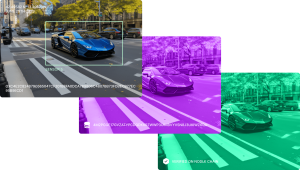
Blockchain Authenticated Real-World Content with Nodle
Nodle, a decentralized network provider, is collaborating with Adobe and the Linux Foundation to use blockchain technology to authenticate captured content from the real world.
Garrett Kinsman, co-founder of Nodle, described the company’s forthcoming software development tool for its ContentSign solution, which will use blockchain to prove the integrity of captured data.

A visualization of Nodle’s ContentSign solution capturing a real-world image that its data cryptographically signed and published on a blockchain. Source: Nodle.
Nodle is contributing ContentSign to the Content Authenticity Initiative, an Adobe and Linux Foundation-led effort to develop a future standard for media authentication.
Nodle is developing a multitude of blockchain-based technologies for the capture and validation of real-world data.
Its primary offering is a network leveraging smartphone Bluetooth connectivity to rent computing power, storage, and the Bluetooth capability of devices to broaden the footprint of IoT networks.
Kinsman states that ContentSign will be an element of this puzzle as a way to demonstrate that a physical camera or device has captured a specific piece of visual media and its associated metadata.
“The way this is done is by having a stamp that proves that a genuine camera has captured the video, the video has been signed by the private key only known by this camera, and a footprint of this video has been published to a blockchain.”
The technology could be beneficial for a variety of applications, including journalism.
As the video is recorded, ContentSign ensures it is stamped and signed with a unique private key exclusive to that specific camera.”
As Kinsman hypothetically explains, a journalist could capture a video or image of a breaking news event using a camera embedded with ContentSign technology.
The imprint of the video would then be minted as a non-fungible token on the Nodle blockchain. The signature verifies that the content comes from an authentic source and has not been altered or generated artificially.
Kinsman adds that the service is replicated on a mobile phone through ContentSign’s SDK in the current iteration, but future implementations could resemble the technology found in cryptocurrency hardware wallets.
“In the future, the camera will embed a secure element, similar to what you can find on a Ledger hardware wallet.”
As the production of AI-generated content increases, the need for solutions capable of distinguishing between authentic and fabricated content will increase, making blockchain-based solutions similar to ContentSign crucial.
“Blockchains, with their inherent characteristics of decentralization, transparency, censorship resistance, and immutability, provide an essential framework to anchor authenticity.”
According to Kinsman, ContentSign is being investigated as a solution for the insurance industry to process claims accurately and with integrity.
ContentSign will ensure that the submitted visual proof for insurance claims is genuine and has not been tampered with or generated by AI.
